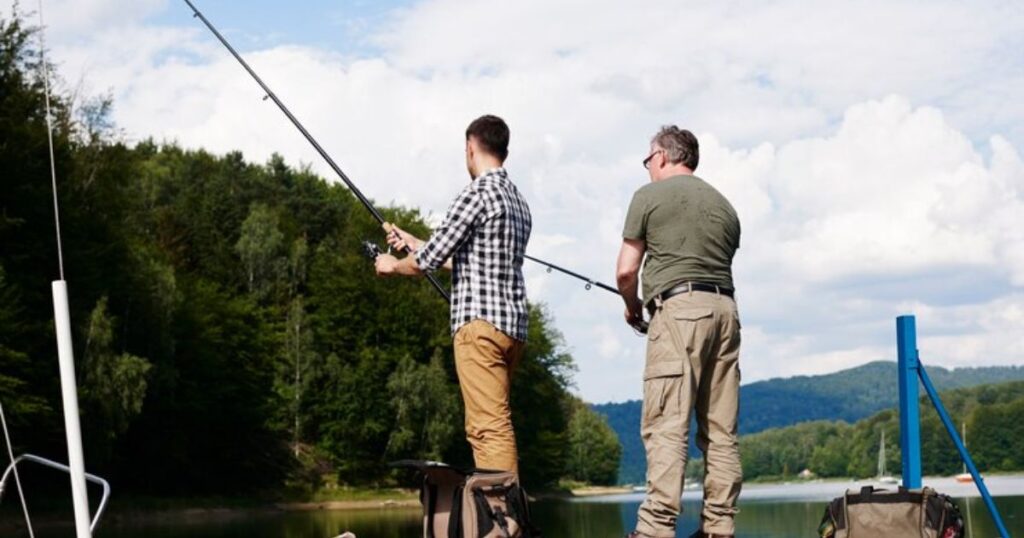When it comes to selecting the best line for a baitcaster, anglers are presented with a multitude of options. Each type of line has its own unique qualities that cater to specific fishing situations. Whether you are a seasoned angler or a beginner, choosing the right line can greatly impact your fishing success. This article aims to provide a comprehensive overview of the different types of lines available for baitcasters, including monofilament, fluorocarbon, braided, and hybrid lines.
By understanding the characteristics and benefits of each line, anglers can make an informed decision based on their fishing techniques and desired outcomes. With the right line, anglers can enhance their fishing experience and increase their chances of reeling in that prized catch.
Key Takeaways
- Monofilament line is a versatile and durable choice for baitcasters, suitable for landing large saltwater species and fishing in heavy cover.
- Fluorocarbon line offers superior strength, invisibility, and abrasion resistance, making it ideal for finesse fishing and avoiding spooking fish.
- Braided line has a high strength-to-diameter ratio, minimal stretch, and resistance to abrasion, making it suitable for heavy cover and finesse fishing.
- Hybrid line combines the best characteristics of braided and fluorocarbon lines, providing high strength, low stretch, and invisibility in water, but it may be more expensive and performance may vary.
Monofilament Line
When considering the best line for a baitcaster, many anglers opt for monofilament, like this untangle a baitcaster, due to its versatility and durability. Monofilament line is a popular choice for both saltwater and freshwater fishing due to its unique properties. In saltwater fishing, monofilament line offers several advantages. It has excellent knot strength, making it reliable for landing large saltwater species.
However, one drawback is its reduced sensitivity compared to other lines. On the other hand, when choosing monofilament line for freshwater fishing, anglers should consider the pound test, diameter, and color. Thicker lines are suitable for heavy cover and bigger fish, while lighter lines are ideal for finesse techniques. Additionally, choosing a low-visibility color can improve the chances of fooling wary fish. By considering these factors, anglers can select the right monofilament line for their specific fishing needs.
Fluorocarbon Line
Fluorocarbon line is a highly recommended choice for baitcasters due to its superior strength and invisibility in the water. It offers numerous advantages that make it a favorite among anglers.
One of the pros of using fluorocarbon line for baitcasting is its high abrasion resistance, which allows it to withstand friction against rocks, logs, and other underwater obstacles. Additionally, fluorocarbon line has a low stretch factor, providing increased sensitivity for detecting even the slightest bites. Another advantage is its near-invisibility in the water, making it less likely to spook fish.
However, fluorocarbon line also has its cons. It tends to be more expensive compared to other types of fishing lines, and it can be stiffer, making it less manageable and prone to backlash if not properly handled.
When choosing the right pound test for fluorocarbon baitcaster line, consider the size and species of fish you are targeting, as well as the fishing conditions. Generally, a higher pound test is recommended for larger fish and heavier cover, while a lower pound test works well for smaller fish and open water situations.
Braided Line

What advantages does braided line offer for baitcasters? Braided line is a popular choice among anglers for baitcasting reels due to its unique characteristics and benefits. Here are some advantages of using braided line:
- Superior strength: Braided line is known for its exceptional strength-to-diameter ratio, allowing anglers to use a higher pound test without sacrificing sensitivity.
- Increased sensitivity: Braided line has minimal stretch, providing anglers with enhanced sensitivity to detect even the faintest of bites.
- Abrasion resistance: Braided line is highly resistant to abrasion, making it suitable for fishing in heavy cover or rocky areas.
When choosing the right pound test for braided line in baitcasting reels, consider the fishing conditions. Lighter pound tests, such as 10-20 lb, are ideal for finesse fishing and targeting smaller species. For larger fish or heavy cover situations, a higher pound test, such as 30-50 lb, may be more appropriate. It is essential to match the pound test to the target species and fishing environment to optimize performance.
Hybrid Line
Baitcasting reels offer anglers the advantage of using a hybrid line, which combines the best characteristics of both braided and fluorocarbon lines for optimal performance. A hybrid line is made by fusing together strands of braided line and fluorocarbon line, resulting in a strong, sensitive, and versatile fishing line.
Using a hybrid line has several pros and cons in different fishing conditions. One advantage is its high strength and low stretch, which allows for better sensitivity and improved hook sets. Additionally, its fluorocarbon coating provides excellent abrasion resistance and invisibility in water. However, the downside of using a hybrid line is that it can be more expensive compared to other types of lines, and its overall performance may vary depending on the specific brand and quality.
When selecting the right pound test for a hybrid line on a baitcaster, it is essential to consider the target species and fishing conditions. For lighter fishing applications, such as freshwater bass fishing, a 10-15 pound test hybrid line should suffice. On the other hand, for heavier saltwater fishing, a 20-30 pound test hybrid line would be more suitable. It is crucial to match the pound test to the strength of the rod and reel to ensure optimal performance and avoid line breakage.
Best Line for Specific Fishing Techniques

After considering the advantages and drawbacks of using a hybrid line on a baitcaster, it is important to explore the best line options for specific fishing techniques. When it comes to finesse fishing techniques, choosing the right line is crucial. A fluorocarbon line is often preferred for finesse fishing due to its low visibility in the water and its sensitivity, allowing anglers to detect even the slightest nibbles.
Another technique that requires a specialized line is topwater fishing. In this case, a monofilament line is commonly used for its buoyancy and stretch. This allows for better control and presentation of the bait on the water’s surface. Lastly, for heavy cover fishing, a braided line is recommended for its strength and abrasion resistance, enabling anglers to pull fish out of dense vegetation with ease.
FAQ’s
What type of line is best for baitcasters?
For baitcasters, a braided fishing line is often preferred for its strength, sensitivity, and reduced line memory, providing better performance in various fishing conditions.
Is braid or mono better for baitcasters?
Braided fishing line is generally preferred for baitcasters due to its strength, sensitivity, and low line memory, offering better performance compared to monofilament.
Is 20 lb braid good for baitcaster?
Yes, 20 lb braid is a versatile and commonly used line weight for baitcasters, suitable for a range of fishing applications and providing a good balance of strength and sensitivity.
Conclusion
In conclusion, the best line for a baitcaster depends on various factors, including the fishing technique employed. While monofilament line offers versatility and ease of use, fluorocarbon line provides excellent invisibility in the water. Braided line offers strength and sensitivity, while hybrid line combines the benefits of different materials. Choosing the most suitable line for specific fishing techniques ensures optimal performance and success in angling endeavors.










